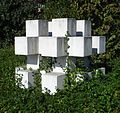Hilgemann's bodies of work from the 1960s focused on wall pieces, consisting of wooden dowels, as well as serial and minimalistic installations ("Space Structures") out of large resin or steel tubes. In the 1970s, reliefs and mostly wooden abstract geometrical sculptures followed, based on grids as well as the cube. [3] The 1980s meant a change in thinking, when Hilgemann made his first photographic work Random Sculptures (for herman de vries), followed by a series of granite boulders e.g. referencing to the (maximum) cube that can fit inside a sphere by cutting away what was needed to reveal the cube, yet showing all parts of the process. [4] In 1982, for the first time with an audience, he rolled a perfectly polished marble cube (150x150x150 cm) down hill in the famous Carrara quarry, where Michelangelo already got his marble from. The result was a scratched and battered piece, but it still remained recognisable as a cube! "Rolling Cube 1982 (shortened video)".
Likewise, in 1983 he brought two perfectly polished spheres to a controlled explosion, resulting in fractured pieces carefully accounted for (3 parts for the white Carrara marble, 9 parts for the dark Bardiglio marble). [5] The same year, during sculpture symposium East-West Forum in Dordrecht, Netherlands he made his first welded steel cube, which he threw down from the rooftop of an abandoned factory.
These sculptures and their planned destruction depend to a large extent on random circumstances. However, these can also be premeditated by stipulating their conditions. According to the artist, this equally is the case with his so-called "Implosion Sculptures", which Hilgemann started in 1984 and that are still going on. The perfectly welded stainless steel geometrical shapes are vacuumed by a pump (or by means of water), causing the body to slowly give way to the outside pressure, resulting in a new form, yet leaving a visual reference to the original. The most used shapes are cubes, square columns and pyramids. [6]
In 2014 Hilgemann was invited by the Park Avenue Sculpture Committee to exhibit his work on the median along Park Avenue in New York City for a period of three months, starting in August. [7] For this prestigious environment Hilgemann designed new works for seven locations between 52nd and 67th Street, all made of stainless steel in different configurations, single pieces as well as groups of two or more. [8]
Works in public spaces (selection)
2021 Threesome, EUREF Campus, Berlin, Germany [9]
2020 Three of a kind, Smalley Sculpture Garden, California [10]
2017 Imploded pyramid, Grugapark, Essen, Germany [11]
2011 Three Graces, Bad Soden, Germany
2010 Imploded Column, New Pacific, Beverly Hills, California
2006 Quint, Hervormd Lyceum, Amsterdam, Netherlands [12]
2005 Double-Up, Aegon Collection, The Hague, Netherlands
2004 Panta Rhei, City of Hünfeld, Germany
2000 Cerberus, Investment Bank Berlin, Germany
1996 Imploded Cube, Il-San Sculpture Park, Ko-Yang City, Korea
1995 Imploded Column, City of Sárospatak, Hungary
1992 Fountain, City of Ingolstadt, Germany
1992 Delft Implosion, Technical University Delft, Netherlands
1991 Plus Minus, City of Gorinchem, Netherlands (co-production Jan van Munster)
1991 Homage to Brancusi, City of Galati, Romania
1990 Reflection, City of Nivala, Finland
1989 Tension, City of Rotterdam
1987 Birth, City of Heemstede, Netherlands
1986 Rolling Cube, City of Sion, Switzerland
1986 Natura Artis Magistra, University Nymegen, Netherlands
1986 Imploded Column (Elblag Implosion), Elblag, Poland
1986 Imploded Pyramid, City of Kleinsassen, Germany
1985 Imaginary Landscape, IWO, Amsterdam, Netherlands
1985 Exploded Sphere, Sculpture Park, Dordrecht, Netherlands
1983 Finnish Landscape, City of Kemi, Finland
1979 Field of 32 Cubes, City of Brielle, Netherlands
1978 1+2=3, City of Gorinchem, Netherlands
1974 Three equal volumes, City of Gorinchem, Netherlands
1972 Cube Structure, City of Gorinchem, Netherlands
1969 Space Structure (Bijlmer), City of Amsterdam, Netherlands
Space Structure (1969). Bijlmerpark (a.k.a. Nelson Mandelapark),
Amsterdam Cube Structure (ca. 1972).
Gorinchem Three equal cubes (1974). Brick.
Gorinchem Exploded Sphere (1983). Carrara Marble.
Dordrecht Two equal volumes (2017-2023). Stainless Steel, Anningahof,
Zwolle






